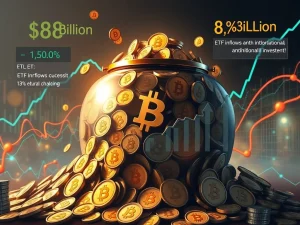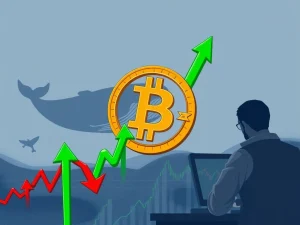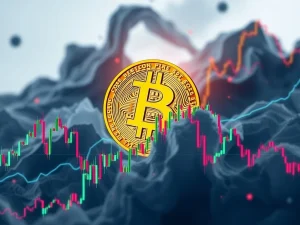Bitcoin’s Immense Potential: Can It Absorb the $30T US Treasury Market?

Get ready for a bold claim that challenges traditional finance! The CEO of Bitwise, Hunter Horsley, suggests that Bitcoin isn’t just vying for gold’s spot; it’s also competing directly with the massive US Treasury market. This perspective dramatically expands Bitcoin’s potential reach, positioning it against one of the world’s largest and most trusted savings instruments.
Bitcoin vs. The $30 Trillion US Treasury Market
Bitwise CEO Hunter Horsley argues that Bitcoin’s total addressable market goes beyond the $16 trillion gold market. He points to the over $30 trillion US Treasury market, which is widely used by individuals and institutions as a store of value. Traditionally, US Treasuries were seen as a safe haven, a place investors would flock to during times of uncertainty. However, this view is starting to shift.
Economist Mohamed El-Erian recently noted that flows into US Treasuries are no longer a reliable indicator of a flight to safety. Instead, he suggests watching gold and silver, traditional hedges against inflation. This changing sentiment opens the door for alternative assets like Bitcoin to gain traction as a potential safe haven and store of value.
Why Rising Government Spending Matters for Bitcoin
One key factor driving interest in Bitcoin as an alternative store of value is the increase in government spending and national debt. Geopolitical tensions and significant fiscal expansion can erode the purchasing power of fiat currencies through inflation. When governments spend excessively, it raises concerns about long-term fiscal health and currency stability.
For example, proposed deficit spending, like the estimated $2.5 trillion under consideration in the US, adds to an already substantial national debt nearing $37 trillion. Critics argue this level of spending is unsustainable and could further destabilize the economy. This environment makes assets with perceived scarcity and resistance to central control, like Bitcoin, more appealing to those looking to protect their wealth.
The Bond Market Reacts: Opportunity for Bitcoin?
The concerns over fiscal health have tangible effects on financial markets, particularly the bond market. In April 2025, the bond market experienced a notable sell-off. Investors reacted to macroeconomic uncertainty, including trade tariffs and rising debt levels, by offloading US government securities. This sell-off caused bond yields to spike, as investors demanded higher interest rates to compensate for the increased risk associated with lending to the US government.
Saifedean Ammous, author of The Bitcoin Standard, commented on the situation, stating that the US fiscal situation is poor and that recent policy ideas have unsettled the bond market. This volatility and perceived risk in traditional safe havens can push investors to explore alternatives. As trust in government bonds as an absolute store of value potentially wanes, assets like Bitcoin become more attractive, absorbing capital from individuals and institutions seeking stability outside the traditional system.
Key Takeaways:
- Bitcoin’s potential market isn’t just gold; it includes the vast US Treasury market.
- Rising government spending and national debt fuel concerns about currency stability and traditional safe havens.
- Volatility and risk in the bond market can drive investors towards alternative assets like Bitcoin.
- Bitcoin is emerging as a compelling alternative store of value with properties similar to gold but without counterparty risk inherent in government securities.
In conclusion, the argument that Bitcoin could absorb a significant portion of the US Treasury market highlights its growing acceptance and perceived utility as a robust store of value. As global economic landscapes shift, influenced by geopolitical factors and substantial government spending, the appeal of decentralized assets like Bitcoin increases. The recent reactions in the bond market underscore the fragilities within traditional systems, further solidifying Bitcoin’s position as a potential hedge and a vital component in a diversified savings strategy for the future.









